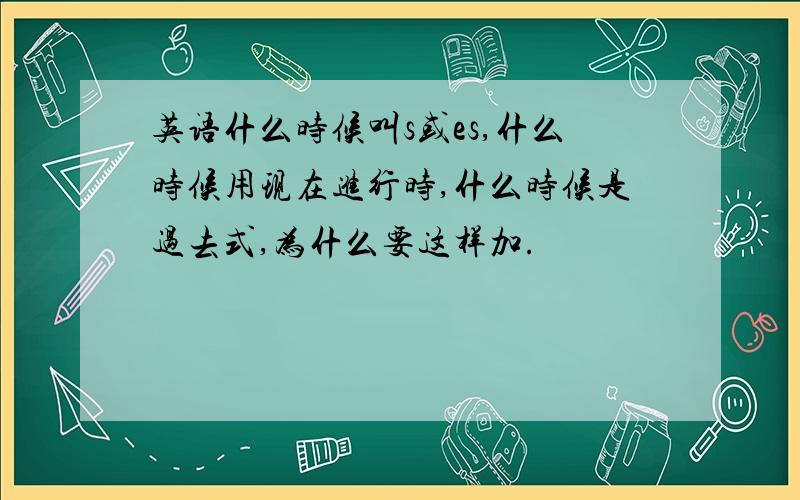英语什么时候叫s或es,什么时候用现在进行时,什么时候是过去式,为什么要这样加.
来源:学生作业帮助网 编辑:作业帮 时间:2024/04/28 07:26:56

英语什么时候叫s或es,什么时候用现在进行时,什么时候是过去式,为什么要这样加.
英语什么时候叫s或es,什么时候用现在进行时,什么时候是过去式,为什么要这样加.
英语什么时候叫s或es,什么时候用现在进行时,什么时候是过去式,为什么要这样加.
名词复数的变化
1、 名词复数的规则变化
成对的共有10对:
清 浊
[p] [b]
[t] [d]
[k] [g]
[f] [v]
[s] [z]
[θ] [Б ]
[∫] [З]
[ts] [dz]
[t∫][dЗ]
[tr] [dr]
另外,清辅音还有:[r]、[h],一共是12个.
浊辅音还有:[m]、[n]、[ŋ]、[l]、[j]、[w],一共是16个
一般情况
加 -s
清辅音后读/s/
map-maps
浊辅音和元音后读 /z/
bag-bags /car-cars
以s, sh, ch, x等结尾
加 -es
读 /iz/
bus-buses/ watch-watches
以ce, se, ze,等结尾
加 -s
读 /iz/
license-licenses
以辅音字母+y结尾
变y 为i再加es
读 /z/
baby---babies
2、 其它名词复数的规则变化
1) 以y结尾的专有名词,或元音字母+y 结尾的名词变复数时,直接加s变复数.例如:
two Marys the Henrys
monkey---monkeys holiday---holidays
2) 以o 结尾的名词,变复数时:
a. 加s,如: photo---photos piano---pianos
radio---radios zoo---zoos;
b. 加es,如:potato--potatoes tomato--tomatoes
(注意:英语中只有四个以O结尾加es的单词:negro,hero,tomato,potato)
c. 上述a和b两种方法均可,如zero---zeros / zeroes.
3) 以f或fe 结尾的名词变复数时:
a. 加s,如: belief---beliefs roof---roofs
safe---safes gulf---gulfs;
b. 去f,fe 加ves,如:half---halves
knife---knives leaf---leaves wolf---wolves
wife---wives life---lives thief---thieves;
c. 上述a和b两种方法均可,如handkerchief: handkerchiefs / handkerchieves.
3 、名词复数的不规则变化
1) child---children foot---feet tooth---teeth
mouse---mice man---men woman---women
注意:由一个词加 man 或 woman构成的合成词,其复数形式也是 -men 和-women,如an Englishman,two Englishmen.但German不是合成词,故复数形式为Germans;Bowman是姓,其复数是the Bowmans.
2) 单复同形,如deer,sheep,fish,Chinese,Japanese ,li,jin,yuan,two li,three mu,four jin等.但除人民币的元、角、分外,美元、英镑、法郎等都有复数形式.如:a dollar, two dollars; a meter, two meters.
3)集体名词,以单数形式出现,但实为复数.例如:
people police cattle 等本身就是复数,不能说 a people,a police,a cattle,但可以说a person,a policeman,a head of cattle, the English,the British,the French,the Chinese,the Japanese,the Swiss 等名词,表示国民总称时,作复数用,如The Chinese are industries and brave. 中国人民是勤劳勇敢的.
4) 以s结尾,仍为单数的名词,如:
a. maths,politics,physics等学科名词,一般是不可数名词,为单数.
b. news 为不可数名词.
c. the United States,the United Nations 应视为单数.
The United Nations was organized in 1945. 联合国是1945年组建起来的.
d. 以复数形式出现的书名,剧名,报纸,杂志名,也可视为单数.例如:
"The Arabian Nights" is a very interesting story-book. 《一千零一夜》是一本非常有趣的故事书.
5) 表示由两部分构成的东西,如:glasses (眼镜) trousers, clothes等,若表达具体数目,要借助数量词 pair(对,双); suit(套); a pair of glasses; two pairs of trousers等.
6) 另外还有一些名词,其复数形式有时可表示特别意思,如:goods货物,waters水域,fishes(各种)鱼.
4 、不可数名词量的表示
1)物质名词
a. 当物质名词转化为个体名词时为可数.
比较:Cake is a kind of food. 蛋糕是一种食物. (不可数)
These cakes are sweet. 这些蛋糕很好吃. (可数)
b. 当物质名词表示该物质的种类时,可数.例如:
This factory produces steel. (不可数)
We need various steels. (可数)
c. 当物质名词表示份数时,可数.例如:
Our country is famous for tea. 我国因茶叶而闻名.
Two teas, please. 请来两杯茶.
2) 抽象名词表示具体的事例时也可数.例如:
four freedoms 四大自由 the four modernizations四个现代化
物质名词和抽象名词可以借助单位词表一定的数量,如a glass of water 一杯水/ a piece of advice 一则建议.
5. 定语名词的复数
名词作定语一般用单数,但也有以下例外.
1) 用复数作定语.例如:
sports meeting 运动会 students reading-room 学生阅览室
talks table 谈判桌 the foreign languages department 外语系
2) man, woman, gentleman等作定语时,其单复数以所修饰的名词的单复数而定.例如:
men workers women teachers gentlemen officials
3) 有些原有s结尾的名词,作定语时,s保留.例如:
goods train (货车) arms produce 武器生产
customs papers 海关文件 clothes brush 衣刷
4) 数词+名词作定语时,这个名词一般保留单数形式.例如:
two-dozen eggs 两打鸡蛋 a ten-mile walk 十英里路
two-hundred trees 两百棵树 a five-year plan. 一个五年计划
二、进行时态
1.现在进行时
(1)表示现在正在进行的动作,常与now,right now,at the mother,for the time being,for the present等连用.例如:
Don’t disturb her. She is reading a newspaper now.
(2)表示现阶段经常发生的动作,常与always,continually,forever,constantly等连用.例如:
My father is forever criticizing me.
(3)表示根据计划或安排在最近要进行的事情.具有这种语法功能的动词仅限于过渡性动词.即表示从一个状态或位置转移到另一个状态或位置上去的动词.常用的有:go,come,leave,start,arrive,return等.例如:
They are leaving for Hong Kong next month.
(4)有些动词不能用进行时,这是一类表示“感觉,感情,存在,从属”等的动词.如:see,hear,smell,taste,feel,notice,look,appear,(表示感觉的词);hate,love,fear,like,want,wish,prefer,refuse,forgive(表示感情的动词);be,exist,remain,stay,obtain(表示存在状态的动词);have,possess,own,contain,belong,consist of,form(表示占有与从属的动词);understand,know,believe,think,doubt,forget,remember(表示思考理解的动词).但是如果它们词义改变,便也可用进行时态.例如:
1)Tom looks pale. What’s wrong with him?
(look在此为联系动词,意为“显得,看上去”)
2)Tom is looking for his books.
(look在此为实义动词,意为“寻找”)
2.过去进行时
过去进行时表示一个过去的动作发生时或发生后,另一个过去的动作正在进行,或表示过去反复的习惯,常与always,continually,constantly等动词连用.例如:
1)We were discussing the matter when the headmaster entered.
2)Whenever I visited him, he was always writing at the desk.
3.将来进行时
将来进行时主要表示将来某一时刻正在进行的动作,或表示要在将来某一时刻开始,并继续下去的动作.常用来表示礼貌的询问、请求等.例如:
1)This time next day they will be sitting in the cinema.
2)What will you be doing at six tomorrow evening?
一般过去时
(1)表示过去某一特定时间所发生的、可完成的动作或状态,常与表示确切过去时间的词、短语或从句连用.例如:
We went to the pictures last night and saw a very interesting film.
(2)表示过去习惯性动作.例如:
1)He always went to class last.
2)I used to do my homework in the library.
(注意与be used to doing短语的区别)